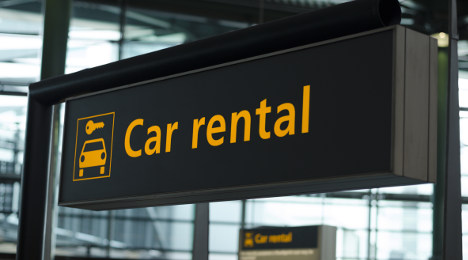J.D. Power Valuation Services (formerly NADA Used Car Guide) recently rolled out a white paper aimed at tackling two important questions when it comes to the impact off-rental has on the wholesale market.
Analysts explained that the percentage of total new vehicle sales sold to rental companies — what is termed rental fleet penetration (RFP) — generally stands at about 10 percent to 13 percent, representing roughly 1.5 to 2 million vehicles.
“Their entrance into the used market generally occurs within one to two years after being purchased new — or much sooner than the typical retail consumer purchase or lease,” J.D. Power said in the white paper. “In addition, rental fleet companies tend to sell large quantities of off-rental units around the same time. More often than not, the concentrated influx of off-rental supply places negative downward pressure on used vehicle prices.
“A second concern involves the relationship between high RFP and automaker brand value,” analysts continued. “For example, brands or models consistently associated with high RFP frequently exhibit weaker quality or reliability characteristics—or are perceived less favorably by consumers.”
With that set of scenarios as a backdrop, J.D. Power wanted to address a pair of open questions, including:
1. How large is the negative pressure on used vehicle prices from increased supply resulting from new vehicle sales to rental companies?
2. Supply impact aside, do rental fleet sales have a longer-term impact on brand value factors, or is high RFP more a symptom of pre-existing brand weakness?
“This paper explores the relationship of rental fleet sales to used vehicle prices through two conjectural mechanisms: The first is through an increase in supply volume; the second is through damage to brand reputation and brand value,” analysts said in the J.D. Power white paper that can be downloaded here.
An online booking platform for luxury car rentals is gaining more financial steam to match the type of vehicles it offers to clients.
CarHopper — which offers Ferraris, Bentleys, Lamborghinis and McLarens to customers in five different cities known for this kind of luxury — announced on Tuesday it has raised $1.5 million in seed funding.
The company said it also has expanded its operations to include Los Angeles; Las Vegas; Orlando, Fla.; and Fort Lauderdale, Fla. CarHopper explained the capital — which was raised from a syndicate of angel investors — positions the startup already as a top player in the Miami entrepreneurial scene where it is headquartered.
An initial $500,000 was raised in the fourth quarter when the startup operated as booking platform for local and independently owned car rental companies. CarHopper also announced today it has honed its focus to a more curated inventory, sourced from boutique luxury car rental purveyors.
CarHopper just secured an additional $1 million, which will help the company expand its sales and marketing efforts, as well as accelerate product development, bringing the raise to a total of $1.5 million in the last six months.
With the growth of online marketplaces and the sharing economy, CarHopper founder and chief executive officer Bora Hamamcioglu noted that consumers now have a wider variety of channels to access goods and services in non-traditional ways.
“Latest trends demonstrate that people prefer buying experiences rather than assets,” said Hamamcioglu said.
The additional funding builds on what the company described as a strong year for CarHopper, which saw a rapidly growing roster of clients and market momentum expanding their services in key cities like Los Angeles, Las Vegas, and across South Florida — markets in which luxury car rental demand continues to grow based on lifestyle trends and the rising global tourism industry.
“We are very excited to pioneer the growth of this highly fragmented market and streamline the process of renting luxury cars through our innovative technology,” Hamamcioglu said.
For more information, visit www.carhopper.co or download its mobile IOS or Android applications.
Fox Rent-A-Car announced on Thursday its final acquisition of JustShareIt, a cloud-based peer-to-peer car sharing platform specifically designed to allow users to rent or share cars directly from individual car owners.
Over the past 12 months, Fox said it has worked alongside JustShareIt to integrate the mobile-friendly product with its platform so that Fox members can begin to pick up and drop off cars at a variety of decentralized locations.
“Fox's new mobile experience enables customers to reserve a car, bypass the rental counter and proceed directly to the car. Customers will then choose their vehicle and drive off,” the company said in a news release.
Currently, the new service is only ready for use at Los Angeles International Airport. Within a few months, it will become available at most of the car rental brand’s corporate locations, according to Fox.
"The new integrated platform will help Fox to not only offer the customers a rental at a much faster speed, but will also create new business models that are not currently available in car rental industry,” Fox co-chief executive officer Mike Jaberi said. "The JSI platform acquisition has enabled Fox to explore new opportunities in a hybrid model of car rental and car share at a much faster pace."
Additionally, Fox also announced that it is currently in discussions with two automobile manufacturers to fit a group of its fleet with connected car technology.
Fox now offers service at 19 major corporate owned airport locations throughout the U.S., along with more than 110 affiliate sites.
Cox Automotive chief economist Tom Webb explained why February’s wholesale price data reinforced a possible market moniker — stability.
Manheim reported on Tuesday that wholesale used-vehicle prices (on a mix-, mileage-, and seasonally adjusted basis) fell by 0.2 percent in February. However, Webb pointed out that given a sharp decline in pricing in February of last year, the Manheim Used Vehicle Value Index showed a year-over-year gain of 1.1 percent as the index reading stood at 124.6 for February.
“Although wholesale prices rose in only one month out of the last seven, stability remains the watchword for used-vehicle values given that all of the declines were small,” Webb said in his commentary that accompanied the latest index update.
“In the face of heavy new-vehicle inventory and incentives, the stability of used vehicle values is a credit to the retail market that continues to provide dealers the ability to quickly retail wholesale acquisitions at reasonable grosses,” he continued.
Webb’s observer colleagues from Cox Automotive — Kelley Blue Book’s Alec Gutierrez and Autotrader’s Michelle Krebs — as well as Jessica Caldwell from Edmunds — recently discussed the new-vehicle market’s impact on potential used-vehicle sales performance, too. This Auto Remarketing report highlighted how those analysts noted challenges franchised dealerships face in finding buyers for their new models — which in some cases are taking the amount of days to turn not seen in almost eight years.
Pricing trends by market class
Price declines and rises split evenly within the six vehicle segments Manheim tracks for its monthly update, again showing the cut between cars and trucks.
Each of the three segments to post price gains in February were in the truck category as prices for pickups rose 6.5 percent, prices for vans climbed 4.9 percent and prices for SUVs and CUVs moved 2.0 percent higher.
Conversely, prices in the three car segments all softened in February, led by luxury cars (down 2.2 percent) and closely followed by midsize cars (down 2.1 percent) and compacts (down 1.6 percent).
“Although it remains the case that pricing for trucks, CUVs, and vans remains up year-over-year while cars are down, the weakest of the car segments (compacts) has actually tracked the overall market the past three months,” Webb said. “It is risky to say that compacts reached their bottom because there have been so many false bottoms over the past couple of years, but there are promising signs.
“On a non-seasonally adjusted basis, sports cars were the only segment that was up, but the February lift was much less than normally occurs,” he continued. “As such, the seasonally adjusted price for sports cars in February was down more than any other major segment. This might have been one area where reduced tax refunds did have an impact.”
Rental market update
Manheim reported that the volume of rental-risk units actually sold grew during the first two months of 2017, even though conversion rates were a “little weak,” according to Webb.
“Given that new-vehicle sales into rental were down during this period, it suggests that the rental companies were getting their fleets right-sized,” he added.
Manheim indicated a straight average of auction pricing for rental risk units in February generated a 5-percent lift from a year ago.
“But much of that reflects mix shifts and mileage changes as well as a temporary weakness in the market last year,” Webb said.
“Our index of rental risk pricing that adjusts for broad changes in mix and mileage was down both sequentially (1.2 percent) and year-over-year (3.8 percent),” he continued.
Manheim went on to mention the average mileage on rental risk units sold at auction was 39,100 miles, “which is very close to what it has averaged since the summer of last year,” Webb said.
Enterprise Fleet Management announced that out of nearly 900,000 automotive technicians working in the U.S. — its management customer support supervisor Kelley Hatlee is one of only 16 individuals to earn the 2017 ASE World Class Technician Award from the National Institute for Automotive Service Excellence (ASE) and the Auto Care Association.
Fewer than 2,000 individuals have been honored since the award program began more than 30 years ago.
"Only a handful of technicians master the skills necessary to earn the ASE World Class Technician Award," Tom Gieseking, vice president of fleet operations for Enterprise Fleet Management said in a news release. "This rare honor speaks to the dedication and professionalism Kelley brings to Enterprise Fleet Management and to our customers on a daily basis."
Individuals must test and procure ASE certification in 22 specialty areas in order to earn recognition as a World Class Technician.
Hatlee receives the prestigious honor after earning the titles of ASE Master Automobile Technician, ASE Master Medium/Heavy Duty Truck Technician and ASE Master Collision Repair Technician, and two other advanced level diagnostic certifications for gasoline and diesel engines.
Currently, he holds a total of 32 ASE certifications.
Hatlee has more than two decades of automotive industry experience. He joined Enterprise Fleet Management 11 years ago.
As customer support supervisor for Enterprise Fleet Management's National Service Department, Hatlee leads a team of subject matter experts who are responsible for technical assistance, recall management, vendor relations, fleet support, vehicle maintenance and training.
The National Service Department employs more than 100 ASE-certified service technicians.
“Enterprise was the first fleet management company to win the ASE 'Blue Seal of Excellence' award and has won for 20 consecutive years, an industry record,” Enterprise Fleet Management added.
The global car rental market, which offered an opportunity of $87.07 billion in 2015, is expected to rise at a compound annual growth rate of 14.40 percent during the period from 2014 to 2024, says a recent research report.
A report by Transparency Market Research (TMR) suggests the market's valuation is likely to reach $290.07 billion by the end of 2024.
These trends mean more robust choices for dealers looking to acquire off-rental units as the report indicated rental companies are broadening fleet sizes and including technical gadgets such as GPS and music systems in the vehicles.
A key factor behind the longevity of this market is continuing demand for car rental services for airport transportation, according to TMR’s study titled Car Rental Market – Global Industry Analysis, Trend, Size, Share and Forecast, 2016 – 2024.
The car rental industry is most driven by the growth of the traveling and tourism industry.
Airport transport, outstation traveling, and local usage are the main categories of car rental services.
“Currently, the market for car rentals in North America is highly concentrated with the significant presence of regional and domestic enterprises, across the U.S. and Canada,” TMR said in a news release.
Collectively, Rent-A-Car, Avis Budget Group, Hertz, EuropCar and Sixt accounted for more than 75 percent of the overall market in 2015, finds the new study.
Leading car rental service providers are taking advantage of this trend by promoting their brands at major airports, says TMR.
Currently, North America dominates the car rental market.
According to analysts, in 2015, it held a share of more than 30 percent of overall revenue generated.
TMR’s team of analysts, researchers and consultants use proprietary data sources to collect and analyze information.
For a description of the Car Rental Market – Global Industry Analysis, Trend, Size, Share and Forecast, 2016 – 2024 report and information about how to obtain it visit its web page.
With vehicle shopper preference for SUVs and crossovers apparently strengthening and not waning, Cox Automotive chief economist Tom Webb is confident used-car managers should find higher amounts of those units flowing through the wholesale market this year, especially as off-lease models.
It’s all part of the wholesale surge where Webb is expecting overall wholesale volume to approach 7.8 million units by the end of next year, as more than half of that figure should be off-lease vehicles.
When asked about how the off-lease lanes might shift away from being full of less-desirable compact and midsize cars, Webb replied, “I think the worst of the imbalance is actually over where the product was relatively new in some of those crossover vehicles, which have a lot of appeal.
“They were not coming back off-lease yet, but that now has occurred,” he continued during his quarterly conference call with the media and investment analysts on Monday. “We’re now where those volumes are growing. I think that will be very helpful. It’s much more balanced than it was in the past.
“Still there are a large number of compact, basic model sedans that are being leased. But you could also argue that the consumer preference shift away from those vehicles might have already played out,” Webb went on to say.
Later in the call, Webb mentioned leasing activity increased for vehicles now in high demand, models such as Ford Escape and Toyota RAV4. Auto Remarketing went back to the State of the Automotive Finance Market Report generated by Experian Automotive that contained information from the first quarter of 2014. Turns out, Experian’s report showed that 2.91 percent of all new-model leases in the quarter were Escapes; a reading second to only the mark connected with Honda Civic at 3.45 percent.
And Experian indicated 1.97 percent of all new-model leases in Q1 2014 were for the RAV4. Meanwhile, another popular compact SUV — the Honda CR-V — also was among the top 10 leased models in that quarter as that unit generated 2.69 percent of new-vehicle leasing activity during that span.
Now, some of those units are already or soon will be going over the block.
“There are going to be a large number of compact SUV and crossover type models,” Webb said. “I think we’ll be a little more aligned with customer tastes. The overall movement in leasing the past couple of years has been toward mainstream models instead of solely focused on the luxury end of the market.”
Rental-risk unit & new-model incentive analysis
Webb indicated a straight average of auction prices in December for rental risk units sold at auction topped the $17,000 mark for the first time ever and was 5 percent higher than a year ago.
However, after adjusting rental-risk prices for broad shifts in market class and mileage, Webb determined pricing for these units softened by 4.4 percent.
Webb went on to mention the average mileage of rental-risk units sold in December (38,600 miles) was similar to recent months, but 13 percent lower than a year ago. He then reiterated why the 2015 mileage readings that surpassed 50,000 were so unusual.
“That exceptionally high mileage in 2015 was driven by some industry-specific and company-specific factors, which are gone,” Webb said. “My discussions with the rental car companies is that we’re pretty comfortable with that level to maximize value.
“There is going to be a little bit more of a tendency for a wide frequency distribution within that average mileage where there might be opportune times for the rental car companies can sell a risk unit with low mileage just because it might be hot in the wholesale market at that time,” he continued. “And there are certainly cases where they might want to extend the life, which they can with relative ease.”
And with mileage levels stabilizing, Webb also pointed out that the condition of rental risk units is perhaps as good as it’s ever been. Manheim determined the volume of units going through the wholesale market in the fourth quarter of 2016 with condition grades between 4 and 5 surpassed 40 percent to the highest level going back to Q1 of 2015.
“It was feared that as the rental car companies shifted a higher share of their sales away from auctions over to direct sales to dealers and even retail consumers that the less desirable units would end up at auction,” Webb said. “Clearly that has not been the case.
“That’s because the rental car companies also have an inherent interest in protection residual values overall. The specific brands they hold in their fleet, they know the auction represents the truest form of price discovery and as we say the only venue where you can get more than you asked for,” he went on to say.
Webb closed his off-rental discussion by insisting how much new-vehicle incentives can impact risk-unit price performance.
“With respective to incentive activity, (rental-risk units) are basically 1-year-old vehicles so they’re extremely sensitive to the incentive activity that’s going on within the new-vehicle side of the market,” he said. “We’ve been relatively but not overly aggressive. I know there are some concerns that incentive levels are at record levels, maybe adjusting them for the transaction price. But my general sense of the market is that it hasn’t destroyed the overall wholesale values at the current time. There are obviously specific segments of the market like it’s certainly hurt the compacts. There is some intense pressure to move the new units that people really don’t want to buy.
“In terms of the go forward, I’m still relatively optimistic that they don’t go crazy in terms of an incentive war,” Webb went on to say. “This cycle is a little different than previous ones where you have to realize the manufacturers themselves basically are holding the residual risk on basically about 10 million lease units that they have in their portfolio. You would think they would keep that in mind when they do their vehicle push.”
You might need to have your bleisure suit dry-cleaned.
J.D. Power’s 2016 North American Car Rental Survey found that travelers who rent a car for business and then combine business and leisure are the most satisfied with their car rental experience.
While overall satisfaction was higher among business travelers than among leisure travelers (satisfaction score of 806 vs. 798 on a 1,000-point scale), satisfaction among “bleisure” travelers (836) was the highest.
This tendency appears to be more pronounced among Gen Y renters (those born between 1977 and 1994), who have a growing presence in the rental car market. Cost and fees satisfaction among bleisure car renters is 43 points higher than among exclusive business renters and 49 points higher than among exclusive leisure renters.
“With such a big bump in satisfaction among ‘bleisure’ renters, it’s certainly worthwhile for rental car companies to take a closer look at ways to attract and accommodate these travelers, perhaps by providing an easy way to separate charges for the business days of the rental from the leisure days, making for easier expense reporting,” said Rick Garlick, global travel and hospitality practice lead at J.D. Power.
“Appealing to bleisure travelers may help differentiate them from competitors, but it could also foster the growth amongst a new base of loyal customers.”
The study, in its 21st year, measures overall customer satisfaction with rental cars at airport locations by examining six factors (listed in order of importance):
—cost and fees
—pickup process
—return process
—rental car
—shuttle bus/van
—reservation process.
Overall rental car satisfaction averaged 804 index points, a 6-point improvement from 2015. All of the ranked brands posted at least some improvement in the cost and fees factor, continuing a noticeable upward trend over the past two years.
“Seeing steady improvements in cost and fees demonstrates that rental car companies are creating greater value for their customers through a combination of improved products and service,” said Garlick.
“Stellar customer service at all touch points of the experience makes a difference for travelers in terms of choice, experience and loyalty. While there is always a segment of renters that cares only about which company provides the lowest price, high service levels drive both value and satisfaction for many customers.”
For the third year in a row, Enterprise ranked highest in satisfaction among rental car companies, achieving an overall satisfaction index score of 830. Enterprise performed particularly well in all six study factors. Enterprise was followed by National (813), Alamo (809) and Hertz (804).
Other survey findings:
—There is a trend toward consolidating rental car facilities to a single site; 32 percent of study participants rented from such a facility. Customer satisfaction with their rental car experience was about the same for a consolidated site as it was for a branded site. However, shuttle bus/van satisfaction among renters who picked up from a consolidated site is 51 points higher than among those renting from a brand-operated site.
—The percentage of reported problems in the 2016 study was 21 percent, an increase from 14 percent in 2015. The increase was driven by many of the unranked brands included in the study. Among customers who experienced a problem, the highest increase in specific reported issues was related to optional equipment, in which the problem incidence increased to 16 percent this year from 10 percent in 2015.
—Among the busiest airports in the United States, Dallas/Ft. Worth International (DFW), Fort Lauderdale Hollywood International (FLL), New York John F. Kennedy (JFK), and Miami International (MIA) performed particularly well in rental car satisfaction.
Enterprise Holdings and its affiliate Enterprise Fleet Management delivered record results in fiscal year 2016.
For the 12-month period ended July 31, the company generated $20.9 billion in revenue. That was an 8.1-percent increase over FY 2015, according to a news release.
As privately held companies, they do not disclose net income.
Enterprise Holdings and Enterprise Fleet Management together own nearly 1.9 million vehicles and more than 9,600 fully staffed locations dozens of countries, making Enterprise the world’s largest car-rental company as measured by revenue, fleet and employees.
“We not only are seeing consistent and significant growth in U.S airport market share, but also across our business lines and in local neighborhoods,” said Pamela Nicholson, president and chief executive officer at Enterprise Holdings Inc., which owns the Enterprise Rent-A-Car, National Car Rental and Alamo Rent A Car brands.
“Consider that our customers are logging more than 25 billion miles throughout the world every year. And many of those miles are driven locally in their very own communities, mostly in late-model, fuel-efficient vehicles,” Nicholson added. “That means our business offers some of the most effective and sustainable options in the ground transportation sector today — and we will continue to do so, even as infrastructure and technology, including autonomous vehicles, evolve in the future.”
Enterprise, National and Alamo brands operate in more than 85 countries and territories on five continents.
“We at Enterprise Holdings are proud of our leadership role in the car rental, travel and automotive industries,” Nicholson said. “Every single day, Enterprise, National and Alamo employees put customers first — regardless of whether the rental is across town or halfway around the world.”
During FY2016, Enterprise Holdings added multiple franchise locations, including Belize, Ecuador, Jamaica, Jordan, Honduras, Luxembourg, Mexico, New Zealand, Qatar, Saudi Arabia, Tortola, Trinidad & Tobago, Turks & Caicos, the United Arab Emirates and Uruguay.
Family owned and operated
Enterprise was founded in 1957 by Jack C. Taylor. Taylor passed away during FY16, but his children remain in senior management positions. His son, Andrew, is executive chairman of Enterprise Holdings, while his daughter, Jo Ann Taylor Kindle, is president of the Enterprise Holdings Foundation.
Two of Jack Taylor’s granddaughters also serve key roles: Christine Taylor as executive vice president and chief operating officer of Enterprise Holdings, and Carolyn Kindle Betz as vice president and executive director of the Enterprise Holdings Foundation.
One of Taylor family’s goals is to carry on the company’s commitment to community-focused philanthropy.
To that end, the Enterprise Holdings Foundation provided $27.3 million in grant funding to charitable causes during FY16. Eighty-nine percent of the grant requests the foundation fulfilled came from employees to help community causes that are of personal importance to them. Large-scale donations in 2016 included support for the American Red Cross Annual Disaster Giving Program and the Canadian Red Cross Fort McMurray, Alberta, disaster relief efforts.
Enterprise Holdings recently published its FY2016 Sustainability Update, highlighting key initiatives such as responsible product lifestyle and growth of urban mobility programs.
“We are seeing more and more questions about sustainability issues and metrics as part of the formal RFP process,” said Nicholson. “That is because major corporate accounts with defined sustainability goals — including Enterprise Holdings — are evaluating and measuring their respective supply chains to a much greater degree than ever before.”
Enterprise Holdings is the only company in the international car rental industry — and one of a handful in the global travel industry — to complete its sustainability reports and updates in accordance with Global Reporting Initiative (GRI) G4 “Core” Guidelines. This annual documentation articulates goals and provides transparency as well as accountability for Enterprise Holdings and its key stakeholders.
If dealers aren’t already looking through the rental-risk unit run sheet at the auctions where they typically buy inventory, perhaps they should be — considering what might be crossing the block nowadays.
“It’s interesting as we note the typical rental-risk unit comprises a much more diverse mix of models, makes and colors than there used to be in the past. That’s good,” Cox Automotive chief economist Tom Webb said. “There are a lot of different options for a dealer when looking at the off-rental units. They can probably buy something that their customer wants.
“The rental fleet is much more diverse. Certainly, it’s skewed to the car side, but a lot of small crossovers because the rental car companies are doing a good job of remarketing them. You’ve got those specialty high-line rental units now, which is also a good thing,” Webb continued.
“Even with the models, the rental car companies do a much better job of contenting the vehicle like a traditional retail unit as opposed to in the past where you could say ‘that’s a rental unit’ because it’s got crank windows or something. Those days are past. There used to be a time where all those were painted white, which was not good either for residual values. It’s a much nicer spectrum of vehicles,” he went on to say.
A year ago when Auto Remarketing compiled its annual report about the off-rental market, Manheim noticed mileage for these units at an all-time high. A streak of four consecutive quarters for mileage increases left the average well above 50,000 miles, more than double the figure Manheim spotted in early 2007.
“The average mileage now is more in tune with what we’ve seen since this recovery started,” said Webb, who put the average at the midpoint of this year at about 38,500 miles. “It’s more like the 2009 through 2014 time period.
“A lot of that was caused by Hertz, primarily the second quarter of 2015, where it hit record highs. They were going through a lot of management changes and they had issues with SEC filings so they just kept their units longer,” Webb added.
Over at KAR Auction Services, executive vice president and chief economist of ADESA Analytical Services Tom Kontos isn’t seeing as much of an average mileage drop-off. Kontos indicated the average mileage for rental-risk units going down the lanes at ADESA is still near 50,000.
“That’s the data I get from our auctions. Maybe more broadly, the trend isn’t quite so high. But at least the units we’re selling at ADESA, we’re seeing pretty high mileage,” Kontos said.
Still, Kontos agreed that off-rental vehicles are a hit with dealers, especially if they can obtain highly coveted program units during closed factory sales.
“The consistency of those (program) vehicles is what it’s always been,” Kontos said. “If they’re not already in good condition, the manufacturers do what they can to recondition them. Those units are always some of the better cars available to dealers at auction.
“The demand and attractiveness of off-rental vehicles is probably better than it already was because it was already pretty good,” Kontos continued. “The rental-risk units have been attractive to franchise dealers because they’re in the younger age category — a current or 1-year-old model.
“What I would add that’s different today is the popularity of certified pre-owned vehicles, where the off-rental unit does lend itself to very well,” he went on to say.
ABC St. Louis general manager Todd Ritter concurred with Kontos’ assertion about the connection of CPO and off-rental vehicles bringing out the hammer at his auction each week.
“I think dealers have always used rentals to fill spots on their lots. With the growth of CPO, we definitely have seen an increase in demand for these vehicles,” Ritter said.
Rising off-rental supply
Both Webb and Kontos pointed out supply of off-rental units in the wholesale market is on the rise simply because rental car company fleets are growing.
“Since the recession ended, new vehicles into the rental fleets have gone up,” Kontos said. “Now it’s not been disproportionate to the growth in new-vehicle sales in general, so it’s not as if manufacturers have been favoring rental sales to the degree they might have before the recession.
“The fact of the matter is there has been growth of new vehicles into the rental fleet, and therefore you would expect growth — and there has been — in off-rental volume over the last few years at auction,” he continued.
And like Webb mentioned, the diversity of rental-risk volume has expanded. No longer are the rental lanes full of domestic, four-door sedans painted white with not many features beyond an engine and transmission.
“The actual volumes are spread across a wider array of manufacturers than there used to be in the past where it was traditionally GM, Ford and Chrysler. Actually GM, Ford and Chrysler’s share of sales into rental is now less than it’s ever been,” Webb said.
“The sales into rental are actually front-loaded into the first part of the year so we’re up about 6.7 percent year-to-date through July,” he continued.
“The interesting thing this year that has gotten a lot of press is General Motors has pulled back very dramatically from new-vehicle sales into rental this year whereas some players have increased,” Webb went on to say.
And while GM might be delivering fewer units to rental companies, what the automaker is doing in the remarketing department is disciplined, too. ABC St. Louis runs hundreds of GM units down its lanes each week.
“Our major rental account (GM) has a standard risk turn-in policy, so they have stayed fairly consistent,” Ritter said.





![KelleyHatlee[1]](https://www.autoremarketing.com/wp-content/uploads/2017/03/KelleyHatlee1.jpg)






